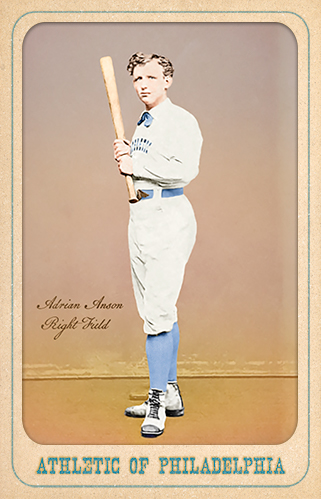- Series: Athletic of Philadelphia: 1874
- City: Philadelphia
- Team: Athletics (NAPBBP)
- League: National Association (NAPBBP)
- Hall: National Baseball Hall of Fame
Adrian Constantine Anson (1852-1922) was Mr. Longevity, a big, brawling cyclone of controversy & batsmanship unrivaled in the early days of pro ball. He set hitting standards that only the greatest future players would approach or break. He also, by dint of his ferocious personality, may have been the single greatest force for segregation in baseball until Branch Rickey began to reverse that sad estate.
- Played a record 27 consecutive years in the NL
- First batter to 3000 hits, using his powerful arms to create line drives with a short swing
- Managed the Chicago NL team to five pennants and still holds the Cub franchise records for hits, doubles, runs scored and runs batted in
- Elected to Hall of Fame: 1939
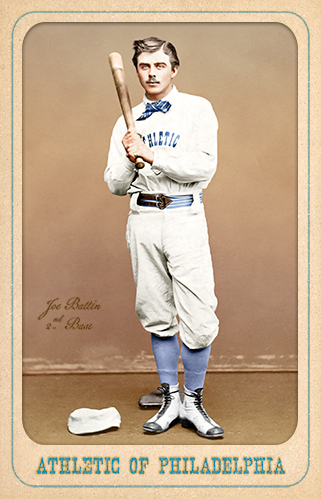
- Series: Athletic of Philadelphia: 1874
- City: Philadelphia
- Team: Athletics (NAPBBP)
- League: National Association (NAPBBP)
Joseph V. Battin (1853-1937) was a scrappy infielder for three National Association teams from 1871-75, remaining with the St. Louis Brown Stockings as they joined the new NL in ‘76. He began with the Cleveland Forest Citys in 1871 at the age of 17, playing just one game in the outfield. After a year off, Joe returned to pro ball with the Athletics in ‘73, again getting into only one game. He caught on the following season, managing to hit .230 for the A’s across 51 games before shipping out to St. Louis for the ‘75 campaign.
Joe's second season in St. Louis, the National League's inaugural season of 1876, was his best as he hit .300 (with a 135 OPS+) in 64 games. He slumped the next year and the Browns sent him to the Alleghenys of Pittsburgh. Joe rarely hit above .200 thereafter and would spend more time in the minors than the majors over the balance of his career.
The 1880s were a time of movement for players and even teams and leagues. But few may have had as head-spinning a season as Joe in 1885. He found himself playing for five teams, three in Waterbury, CT, and each of those in a different league! He began the season with Waterbury’s Southern New England League entry, went back out to Cleveland’s Forest Citys, now in the Western League, back to Waterbury’s Brassmen of the Connecticut State League, up to Binghamton of the New York State League, and finally back in CT with Waterbury’s Eastern League squad.
- Joe got one last shot of big league glory with the Syracuse Stars in 1890, hitting .210 in 29 games
- Battin appeared on the first Hall of Fame ballot in 1936. He received one vote from the Veteran's Committee, tying him with 22 other players including Jake Beckley, Tommy McCarthy, Bobby Wallace, Jesse Burkett, Deacon White & Tim Keefe, and surpassing Candy Cummings who received zero votes
- Series: Athletic of Philadelphia: 1874
- City: Philadelphia
- Team: Athletics (NAPBBP)
- League: National Association (NAPBBP)
John Edgar Clapp (1851-1904) played for 8 teams and managed 6 over a 12 year span, beginning in the National Association with the Middletown Mansfields in 1872 and ending with the NY Gothams in ’83. Primarily a catcher, Clapp had a career BA of .283. With a lifetime 2,523 ABs, he struck out only 51 times.
- Was the first player-manager in major league history (1872)
- Jay Jaffe's JAWS system ranks John as the 88th best catcher in MLB history, just after Bubbles Hargrave and before Ed McFarland
- Earned the nickname “Honest John” after reporting a bookie’s attempted bribe to local police
- The 1881 bribe, in current dollars, amounted to @$119,000
- Fittingly, this Honest John entered police work after retirement from the game and died on the job in his hometown of Ithaca, NY
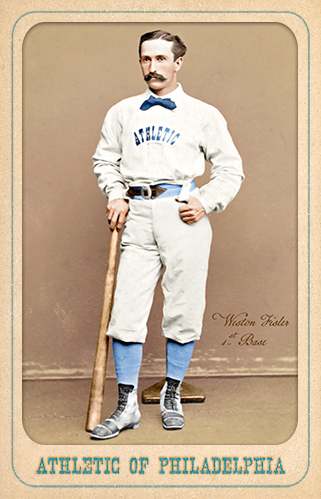
- Series: Athletic of Philadelphia: 1874
- City: Philadelphia
- Team: Athletics (NAPBBP)
- League: National Association (NAPBBP)
Weston Dickson Fisler (1841-1922) was a century too late to fire the shot heard round the world, but the Philadelphia infielder did strike the first blow in a different kind of American Revolution. On April 22, 1876, in the inaugural game of the new National League, the Boston Red Stockings (Red Caps) played Fisler’s Athletics at the Jefferson Street Grounds and Wes scored the first run. It was fitting that such a moment was shared by teams from the two cities most associated with the founding of the nation. And so it was that America celebrated its first centennial with the birth, in Philadelphia, of modern major league baseball.
Fisler grew up in neighboring Camden, N.J., the son of its mayor. At 5’6” and a mere 136 lbs, Fisler was a super-utility "tenth man" with the A’s, playing in 273 games across six seasons, mostly at 1st, 2nd & in the outfield. He had debuted in 1871, the season his team won the first and most controversial championship in the five year history of the National Association (NAPBBP). That pennant wasn’t decided until months after the season ended, when Harry Wright’s Bostons were deprived of their flag by vote of the owners at a November meeting hosted by the liquor-barons who owned the Athletics - a meeting in which their product flowed freely.
- Fisler retired after the ‘76 season with an excellent .310 average, with two HRs, and 189 RBI in his 273 games.

- Series: Athletic of Philadelphia: 1874
- City: Philadelphia
- Team: Athletics (NAPBBP)
- League: National Association (NAPBBP)
This cabinet is currently on the drawing board and is coming soon.
Alfred W. Gedney (1849-1922) was an outfielder for four teams over four years in the National Association of Professional Base Ball Players (NAPBBP). Gedney's tenure in the first openly professional baseball league began in 1872 with the Troy Haymakers, one of the most significant of the early clubs. The "Count" then moved down to Brooklyn’s Eckfords and then over to the New York Mutuals before joining the Philadelphia Athletics in 1874. Gedney then returned to the Mutuals for a final stint in ‘75, where it appears his professional baseball career ended with the demise of the NAPBBP and the establishment of the National League in 1876. Why Gedney did not join with his many NAPBBP compatriots and transition into the new professional league is unknown, but his below average production over his years in the NAPBBP might have been a factor.
- We may only presume that Gedney’s royal nickname derived from his debonair style and elegant handlebar mustache. Early photos depict a confident man of regal bearing, clearly to the manor born.
- In 1872 with Troy, the Count actually placed second in the league in home runs with three. Lip Pike of Lord Baltimore led the league with seven.
- Gedney’s year as an Athletic of Philadelphia was actually his best. He hit .275 and tied for 2nd on the club in RBI with 34. Cap Anson led the team with 37 and Dick McBride was the other at 34.
- For his career, the Count batted .251. He managed only two more home runs following his debut with the Haymakers, and was one of only three Athletics to homer in '74
- The Brooklyn native’s first experience in amateur ball came with the Union of Morrisania (Bronx) team in the old NABBP in 1870
- Was the 137th player to debut in MLB
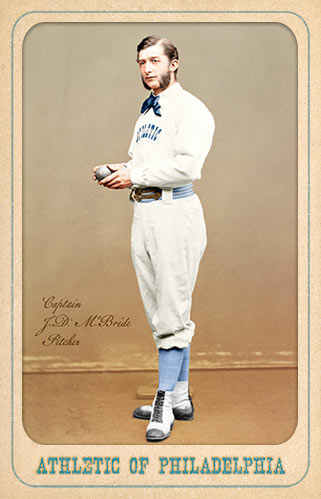
- Series: Athletic of Philadelphia: 1874
- City: Philadelphia
- Team: Athletics (NAPBBP)
- League: National Association (NAPBBP)
John Dickson McBride (1847-1916) was the captain and workhorse moundsman of the Philadelphia Athletics during the team’s five years in the National Association of Professional Base Ball Players (NAPBBP), from 1871-75. Despite piloting the Athletics to a 161-84 (.657) record over 5 years in which he won 149 of those games as a pitcher, McBride suffered the indignity of being ousted as captain (manager) with a mere eight days remaining in the '75 season. Some of the humiliation should have been assuaged by the fact that ownership decided to replace him with a young Adrian Anson - a man who would become perhaps the most formidable and accomplished player of the 19th century.
It would be difficult to overstate McBride's impact with the Athletics. In 1871, Dick led the NA in winning percentage, going 18-5, and leading the team to the circuit’s first pennant, thus winning professional baseball's first league championship. In ‘74 Dick led the NA in ERA at 1.64. Second in career National Association wins only to Albert Spalding, McBride was 149-74 for Philadelphia overall and was putting the finishing touches on an astounding 44-14 season when he was replaced by Anson. (The team's record was 49-18-2 (.731) under McBride. Anson would pilot the team to a 4-2-2 record over the last eight games of the season and the NA would fold shortly thereafter, giving way to the nascent National League in 1876.)
McBride was a Civil War vet and former cricket star who developed into one of the era's best pitchers. No less than Henry Chadwick said of him: “what Dick doesn’t know about the tricks and dodges of strategic pitching isn’t worth knowing.” Years later, former teammate and famous scribe Tim Murnane asserted that Dick was “the first to master the ‘raise ball.’”
- Was apparently renowned as a baseball player as early as 1864, when he was allowed to take a 3-day furlough from his Civil War service to participate in a baseball exhibition
- Completed 224 of the 233 games he started for the Athletics and never once made a relief appearance
- Signed in ‘76 with Boston in the new NL, but didn’t win a game in four outings and retired
- McBride's "most similar" player according to baseballreference is Candy Cummings
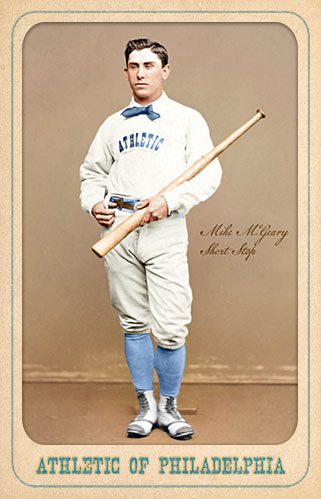
- Series: Athletic of Philadelphia: 1874
- City: Philadelphia
- Team: Athletics (NAPBBP)
- League: National Association (NAPBBP)
Michael Henry McGeary (1851-1933) was, per Sporting Life in 1905, “the best runner in his profession,” due largely because he was “the one player who regularly practiced sliding.” McGeary was also nearly impossible to strikeout. From 1871-76, McGeary fanned only six times in 1,518 plate appearances.
Mike began in pro ball with the Troy Haymakers in ‘70 and stayed with the team as it became a founding member of the National Association the next season. Usually an infielder, Mike was the shortstop for the Philadelphia Athletics when Al Spalding led his Boston club and the A’s on a tour of Britain and Ireland in the summer of 1874. Designed by Harry Wright to promote the game in Europe, the expensive effort failed to generate interest.
McGeary joined the new NL with the St. Louis Browns in 1876 during the era when gambling was rife and William Hulbert was bent on reform. Long-suspected of throwing games, McGeary was the first NL player accused. Suspended and reinstated due to a lack of evidence, Mike continued to generate rumors and suspicion but escaped sanctions and completed over a decade in the game.
- Sporting Life in 1888 described the yellow “parasol” captain McGeary used to signal to the bettors in the grandstands. In one 1875 game, Mike made five of his Philadelphia White Stockings’ 21 errors in a loss to Chicago, reportedly earning each Philadelphia player between $300-$500 from the gamblers.
- From 1871-1875, McGeary averaged 1.22 runs per game, scoring 305 runs in 250 games
- Over his career, McGeary struck out just 60 times in 2,507 plate appearances
- One of the most prominent players of the era, Mike appears on an 1871 Burr Pennfield Troy Haymaker Scorecard. Inspired by and rarer than the Mort Rogers' Scorecards, such "photographic picture cards" were important precursors to the modern baseball card

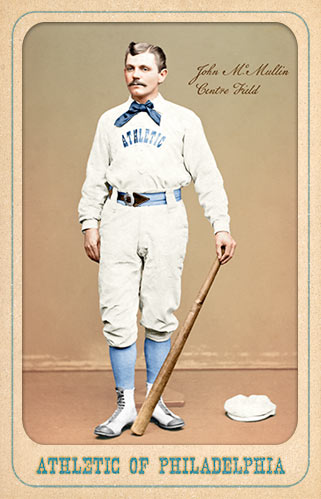
- Series: Athletic of Philadelphia: 1874
- City: Philadelphia
- Team: Athletics (NAPBBP)
- League: National Association (NAPBBP)
John F. McMullin (1849-1881) began amateur ball with his hometown Keystones of Philadelphia in 1867 as an outfielder. He moved to the Buckeye of Cincinnati in ‘68 and the Haymakers of Troy in ‘70, with whom he joined the first openly professional league in 1871. He pitched for Troy his first season when the only other southpaw hurler in the NABBP was Charlie Pabor of the Union of Morrisania (who is more renowned for his nickname, The Old Woman in the Red Cap, than for his mound prowess). McMullin also pitched some for the National Association's Troy entry in ‘71, and is the only known lefty to pitch regularly that year. He served as an emergency pitcher in two games across the 1872 and ‘73 campaigns, but played primarily in the outfield the rest of his career. He always had respectable years at the plate, including his final season with the Philadelphia White Stockings in 1875 where he hit .257. His best year had been with the Athletics in 1874, leading the team with 90 hits and a .346 average.
After being a pioneering member of baseball's first two organized leagues and playing nearly all of his teams' games in the five year history of the National Association, McMullin never played a single game in the National League that replaced it. It is not known why McMullin’s tenure in baseball ended so abruptly on the eve of the modern major leagues and he would die a few short years later at age 32 in his native Philadelphia.
- In 1877, McMullin appeared as one of three managers of a Philadelphia entry in the League Alliance, a loose consortium of teams in the Northeast that formed as a response to the new NL
- Like teammate Mike McGeary, McMullen [sic] appears on an 1871 Burr Pennfield Troy Haymaker Scorecard. Inspired by and rarer than the Mort Rogers' Scorecards, such "photographic picture cards" were important precursors to the modern baseball card


- Series: Athletic of Philadelphia: 1874
- City: Philadelphia
- Team: Athletics (NAPBBP)
- League: National Association (NAPBBP)
- Hall: J.G. Taylor Spink Award Recipient
Timothy Hayes Murnane (1851-1917) vaulted from a career in the early days of the game to become the noted baseball writer for the Boston Globe for three decades. As a player, Murnane had occasional success, but remained less than full time. He did place fifth in the National Association in 1872 with a .359 average for the Middletown (CT) Mansfields. He was in Philadelphia with the Athletics and White Stockings for the final years of pre-modern baseball in the NA before joining the Boston Red Caps (Beaneaters) in the inaugural season of the National League, 1876, and won a pennant the following year. Murnane’s incisive grasp of the game would manifest in a varied career as field manager, executive, owner and minor league president over the ensuing decades. But it was with the pen rather than the bat that Murnane made his greatest mark. In 1946, the Hall of Fame established the Honor Rolls of Baseball to recognize non-player contributions and Murnane was among a dozen scribes enrolled. Murnane was the 1978 recipient of the J.G. Taylor Spink Award commemorating outstanding achievement by the Baseball Writers’ Association of America.
- In his eight-year career as player, Murnane averaged .261. His final season was as player/manager for the Union Association’s Boston Reds as they tried vainly to challenge the NL
- Recipient of the J.G. Taylor Spink Award: 1978

- Series: Athletic of Philadelphia: 1874
- City: Philadelphia
- Team: Athletics (NAPBBP)
- League: National Association (NAPBBP)
This cabinet is currently on the drawing board and is coming soon.
Alfred James Reach (1840-1928) “served baseball with distinction as player, organizer, club owner and provider of the equipment to attain the highest possible skill in the game,” per his own Reach’s Official Base Ball Guide upon his death. “A good man, of the kindest impulses, his name will last as long as we have baseball” expressed the legacy of one of the great men of the early era of America’s game. The London-born, Brooklyn-raised Reach joked that he made the gloves he eschewed in the beginnings of the game in which he starred for the Brooklyn Eckfords and Philadelphia Athletics. He also made the AL’s balls while owning the NL Phillies franchise. A genius for marketing equipment and a lifelong love of the game made him one of the most influential figures of baseball’s first half-century.
- Began play in the amateur era and was a stalwart of the NABBP, first with the Brooklyn Eckfords from 1861-1864, then with the old Athletics of Philadelphia, from 1865-1870
- Made the transition with the Athletics from the NABBP to the NAPBBP in 1871, helping the team win the first professional baseball pennant that year
- Retired from play with the demise of the NAPBBP after the 1875 season
- Founded the NL’s Philadelphia club in 1883, still going strong today as the Philadelphia Phillies
- Built the first modern ballpark in 1887, then rebuilt it with steel after a fire in ‘94
- Al's brother Bob Reach was an MLB shortstop for 3 games, 1872-1873
- Was the 80th player to debut in MLB

- Series: Athletic of Philadelphia: 1874
- City: Philadelphia
- Team: Athletics (NAPBBP)
- League: National Association (NAPBBP)
This cabinet is currently on the drawing board and is coming soon.
John Phillips Jenkins Sensenderfer (1847-1903) was a second baseman and outfielder for the Philadelphia Athletics during the first four years of the National Association of Professional Base Ball Players, from 1871-74. The debonair man with an aura of aristocracy earned his nickname at least in part from the elegant mustache he sported. The Count, a lifelong Philadelphian, had been with the club in the amateur league since 1866, making him one of the true leading lights of baseball’s earliest days. Sensenderfer hit .299 over his ML career, but injuries prevented him from approaching the outstanding batting he displayed in the Athletics’ early days in the NABBP. For example, he scored over 200 runs in 1868 as one of the most prolific of early hitters.
- After leaving baseball, Sensenderfer turned to politics. He was a local county commissioner and active in state Democratic roles as well
- Series: Athletic of Philadelphia: 1874
- City: Philadelphia
- Team: Athletics (NAPBBP)
- League: National Association (NAPBBP)
This cabinet is currently on the drawing board and is coming soon.
Ezra Ballou Sutton (1849-1907). A 3rd baseman & shortstop, Sutton played for 5 teams over 20 seasons. Ezra was the 1st player to hit a home run in Major League baseball and became the 1st player to hit 2 HRs in one game when he hit his second that day (in a losing effort). Sutton was also one of the 1st ball players to collect 1,000 career hits.
- Played in 1st National Association game: 5.4.71
- Played in 1st National League game: 4.22.76
- Lifetime .294 batting average
- Sutton is tied with 17 other players as the first player in major league baseball history
